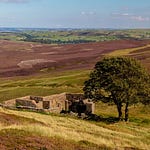The battle over plans for a vast new wind farm on Walshaw Moor has intensified.
The developer has released its EIA Scoping Report for Calderdale Energy Park — a scheme of up to 41 turbines, plus battery storage, roads and cabling, spread across 2,352 hectares of moorland designated as SSSI, SAC and SPA.
At the same time, one of the UK’s leading peatland experts, Richard Lindsay of the University of East London, has used our podcast to challenge Calder Valley MP Josh Fenton Glynn to publish the evidence he is said to have seen showing that wind farms can be built on peat without harm.
Campaign group Save and Restore Walshaw Moor reported on their blog that, during a recent meeting, the MP told them he had been shown data proving there would be no effect — but that he could not share that data. Lindsay’s response:
“We should be allowed to see all of these data and the data should be available for scientific scrutiny for scientific review. It’s just environmental data. If the claim is that all these data are commercial and confidence, then that’s a complete nonsense.” - Richard Lindsay
Josh Fenton-Glynn did not respond to Calderdale Inside Out’s request for comment.
Why peat here is not just “soil”
Lindsay describes the vegetation growing on peat bog as a natural flood barrier:
“If you imagine a thick Persian rug placed on a flat table… the water is going to take some time to filter through the rug before it pours off the table. You take that rug away… the water will just shoot straight off the table and down into our valleys.” - Richard Lindsay
Roads cut across that carpet, drying out moss downslope and funnelling water through drains. In his words: “The main infrastructural element… are obviously the roads… because they cut across the entire peatland hydrology.”
Hebden Bridge flood risk
The moor drains directly into the Calder Valley, where the Hebden Bridge Flood Alleviation Scheme (FAS) is already under development. Lindsay says the interaction must be explicitly modelled:
“If I were in charge of any flood relief scheme, I would be very interested in having data to show me exactly what the implications are for my flood relief scheme.” - Richard Lindsay
“Floating” roads and fixed buffers
The scoping report suggests “floating” roads and fixed hydrology buffers of 100–250m. Lindsay is sceptical:
“Floating roads is a misnomer… these roads don’t float. They sink.”
“100 metres is just a figure plucked out of the air… just using one number works everywhere is a nonsense.” - Richard Lindsay
Carbon payback under doubt
Lindsay cites the Aberdeen University carbon-calculator team’s later peer-reviewed conclusion:
“Construction of a wind farm on relatively undisturbed peat produces no net carbon benefit.”
While Walshaw has been degraded by burning, much of it remains active peat, meaning the carbon balance here is still a live question.
The evidence gap
In our interview, Lindsay was blunt:
“I’ve seen everything from utter catastrophe… through to minor impacts and everything in between. I would love to see that evidence [showing no effect].”
Richard Lindsay
Without published monitoring data, he argues, the debate is being conducted in the dark.
The scoping report stresses the national policy need for renewable energy and commits to:
a full Environmental Impact Assessment and Habitats Regulations Assessment,
management plans for peat, lighting, traffic, restoration and monitoring,
and off-site compensation/BNG.
It also notes turbine bases and cables may remain in situ at decommissioning stage
Who is Richard Lindsay?
Richard Lindsay is Head of the Environmental and Conservation Research Group at the University of East London. He has more than 40 years’ experience studying peatlands, has advised governments and conservation bodies on restoration and climate policy, and is recognised internationally as one of the UK’s foremost authorities on peat hydrology, carbon and biodiversity
Coming soon on Calderdale Inside Out
Earlier this year Calderdale Borough Council granted permission for a highly controversial scheme - the Belmont Waste Incinerator in Sowerby Bridge. Have all the right safeguards been put in place to protect the local population?
Subscribe and get our next episode as soon as it lands.









